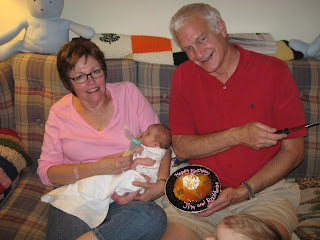When my OB said, "You know, once your water breaks, you're going to have this baby in an hour," I started thinking about how long it takes from the time you arrive at a hospital till you are actually seen by someone. We decided to schedule a time to break my water at the hospital. My doctor gave me two choices, Friday or Monday. Since Monday was the day that Great-Grandpa had put a $500 incentive plan on, I said Monday.
 The Before Picture
The Before PictureMonday, June 16th, at 7:30 in the morning, my entourage showed up at the hospital. Mom and I went to admitting, while Curtis drove Thomas to the sitter's. He was back in plenty of time, since it took an hour and a half (9 am) for the hospital to get things organized and start the I.V. with the Pitocin (to start contractions). Those contractions were SO easy that even though they were 5 minutes apart, I would not have realized that they were the sign to head to the hospital. At 9:30, my doctor came in and broke my water. Now the contractions were definitely painful and it was only about 15 minutes before I was in enough pain that I would not have been able to walk or really do much of anything. If not for the induction, I would have had this baby on the bathroom floor.
Pretty soon, I'm in transition, which means SERIOUS pain. The nurse asks me if I want something for the pain. "YES!!" I gasp, but she just leaves the room. Confused, when she returns, I try to remind her of her offer. "At this point, anything we gave you would slow the baby's heart rate too much." Incredulously and in MAJOR pain, I gasp/shout, "Then WHY did you offer?!"
Another nurse decides that the baby's heart rate is dropping too low, so I get to lay on my side and get oxygen. This is good as my hands and feet had been tingling and going numb. I keep asking (begging) the nurses to let me push (since I remember with Thomas that all the transition pain goes away once you start pushing). They haven't checked me in a while, but couldn't believe I could possibly be at 10 cm yet (HA!) and besides, I should wait for my doctor. I try not to push, but it just hurt too much not to. My secret pushing was revealed when my doctor arrived, helped me roll to my back to check the progress and found that the baby's head was already there. I didn't have to even push for her to be delivered. It was 11:02 am, two hours after they started the I.V. and only an hour and a half since my water broke. (I think it could have been even faster if only they had just let me push.)
 Getting Examined After Delivery
Getting Examined After DeliveryShe came out screaming (which is good), but with the cord wrapped around her (not a problem, since the doctor just clamped and cut it right then). She was cleaned up, but was very white. They were worried that she might be anemic or something, so took her to the NICU to be examined. She pinked up after about 10 minutes, but they kept her for a "four-hour observation." Eventually, she was cleared by a doctor and allowed to go to the regular nursery. They had to do yet another examination and paperwork, while I was making phone calls trying to track down what had happened to my baby, who I had not seen since she was born over 5 hours earlier. At last she was brought to my room, just in time for two cars of visitors to arrive. Car 1 brought Thomas back to us and the second car had Ruthann's godmother and her sister. We all had a good time for an hour or so before visiting hours ended at 8 pm. (Well, all except Thomas who got scared by my reaction when he yanked on my I.V. and then was bored and tired.) As my visitors left, Ruthann was taken back to the nursery to get checked out by her pediatrician. This is getting long, so what happened the rest of the night will be taken up in the next post.
 In My Room, At Last
In My Room, At Last














